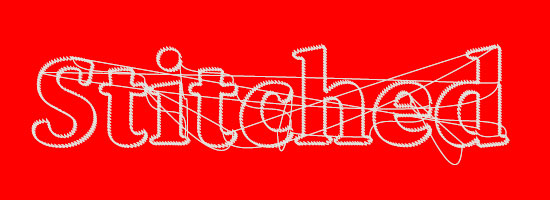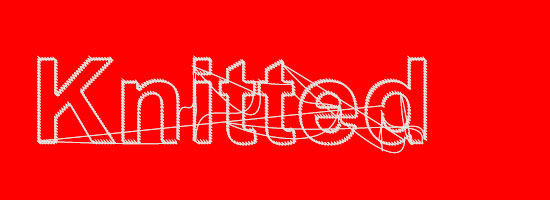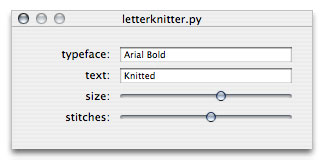LetterKnitter builds on some interesting PlotDevice functionality that allows you to control each point in a Bézier spline or font glyph individually. The LetterKnitter stitches and knits letters and words together, with an occasional error in the stitching process.
LetterKnitter will work with whatever font and text you specify. It isn’t creating a ‘new’ font, but rather applying a path filter that works on any typeface (Dolly and Arial in the examples below), and looks different each time you run the script.



Source Code
var("typeface", TEXT, "Times-Bold") var("text", TEXT, " LetterKnitter") var("size", NUMBER, 100, 10, 200) var("stitches", NUMBER, 700, 10, 1000) def stitch(txt, x, y, n=1000): """ Stitches a given string of text (with n stitches). Creates a text path and finds n points on the path. Connects each consecutive point with a little curve. Sometimes connects to a random point on the path. """ p = textpath(txt, x, y) pt0 = p.point(0) autoclosepath(False) beginpath(pt0.x, pt0.y) for i in range(int(n)): t = float(i) / n pt1 = p.point(t) d = fontsize() * 0.05 curveto( pt0.x, pt1.y, pt1.x + d, pt0.y + d, pt1.x, pt1.y ) if random() > 0.995: pti = p.point(random()) curveto( pt0.x, pt1.y + d*10, pti.x + d, pti.y + d, pti.x, pti.y ) pt0.x = pt1.x pt0.y = pt1.y endpath() nofill() stroke(0.2) strokewidth(1) font(typeface, size) stitch(text, 50, 150, n=stitches)
The path functions used in LetterKnitter are explained in the Bézier Paths tutorial.
Other interesting path filters can be found here.
Created by Tom De Smedt.